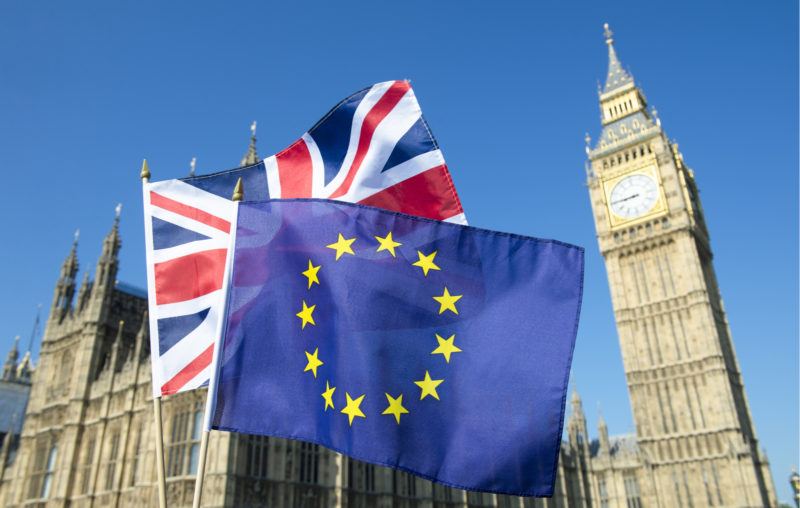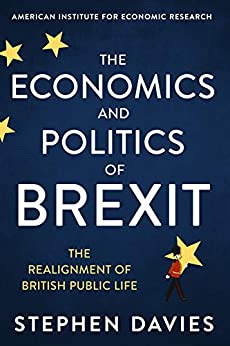Brexit Matters More than Ever

It may be hard to recall now, but a few months ago reports of COVID-19 were buried away in the parts of the papers concerned with world news, in small entries about a mysterious new virus that was reportedly appearing in China. Back then, in late 2019, the news here in the UK, and indeed in many other countries, was full of discussions about Brexit, the recent General Election, and the significance of these for the future.
Right now, the news is so dominated by the current pandemic that little else gets a look in. Other things however have not gone away and in fact the negotiations between the United Kingdom and the European Union about a permanent trade deal following the UK’s exit on 31st January are still continuing (and due to be concluded by the end of this year).
Brexit, and the politics that led to it, have not vanished.
AIER has just brought out a book by myself that tells the story of Brexit and explains how and, more importantly, why it happened. (The Economics and Politics of Brexit: the Realignment of British Public Life). It tells the story of the events that concluded with Britain formally leaving the EU on 31st January 2020, in all their twists and turns.
It explains why events took the course they did, often to the surprise of experts, although much of it should have been clearly foreseeable to anyone who knew what was going on and there were people (including myself) who did realise this and predicted much of what came to pass. The book also explains what the deeper underlying causes of Brexit were and how they were the British instance of a phenomenon that can also be found in many other countries, such as Germany, Sweden, France, and the United States.
The specific events of Brexit are located in a wider story of political change that applies to almost all of the developed world and to many less developed countries as well. The book also explains why Brexit was the form this wider process took in the specific case of the UK.
The key organising concept of the book is political realignment. This is a term much bandied about at the moment but seldom defined. What the book does is give a clear definition of what political alignment and realignment are and to then apply that to recent political events. The key theses are these: there is a realignment of politics underway in the UK and most other developed countries; in the UK it is now almost complete, thanks in no small part to Brexit whereas in some other countries it is still happening; Brexit did not cause this realignment, but it was caused by it; the decision to hold a referendum on EU membership was not frivolous, and the outcome of the referendum was much more likely than most people realised and should not have been such a shock; the paralysis and chaos of 2016-2019 was completely predictable to anyone who had done a BA in politics and was driven mainly by the reaction of the defeated side in the referendum to its result; the elections of 2017 and 2019 together show that a profound change has happened in UK politics or, to put it another way, that the realignment that led to the referendum and its result has now found expression in a transformation of one of the two main parties and a massive shift in voting patterns.
In particular the nature of one of the two ‘sides’ in UK politics has changed, that being the side normally defined as the ‘right.’ The final nature and content of the other ‘side,’ the ‘left,’ is yet to be defined and is currently contested (but see below). This pattern of a transformed right and a conflicted left can also be observed in the United States.
The key concept in the book as mentioned is that of political alignment and realignment. The idea is that in a political community with a representative system of government there will be many contested issues. The number of ways that different views on each individual issue can be combined is very large. In practice we do not find this as politics has an ultimately binary character with voters and politicians divided into two broad camps that most identify with. This is because out of all of the many questions that people disagree about just one or two have a particular salience – they matter a lot to large numbers of people because of structural features of the society and economy.
The most salient issue is the aligning issue; people decide which of the two large and varied sides they belong to on the basis of their position on that issue. This alignment does not last forever though. Eventually the issue loses its salience because it no longer matters to enough people. At this point a new aligning issue gradually appears. The point is that the divisions over this new issue are not the same as those over the old one so a realignment happens; enemies become allies and friends and associates become opponents, voters change their party allegiance, often abruptly and dramatically.
The specific argument about alignment and realignment is one that I first expressed well over ten years ago after it had been gradually forming in my mind through a combination of studying history and observing changes and trends among people that I knew. At this point the argument was a prophecy but over the years it turned into an analysis and it is on the verge of becoming a historical thesis, as what I predicted has come to pass.
The initial impetus came from a book called The Future and its Enemies, by Virginia Postrel, in which she pointed out the appearance of a strange alliance between far-leftists and so-called paleoconservatives such as Pat Buchanan, over their shared hostility to both economic globalisation and the globalist foreign policy of the United States. She argued that there was a new emerging divide between what she called stasists and dynamists, with the disagreement driven by their opposed views of change and innovation. (I think this has proved to be amazingly prescient).
Personally, I became aware that the once-strong alliance between classical liberals and conservatives that had delivered the electoral victories of Reagan and Thatcher was under growing strain and had all the signs of being like one of those increasingly unhappy marriages that all outside observers can tell is headed for the divorce courts, even if the parties themselves do not yet realise it. I arrived at the conclusion that we were seeing the very first intimations of a profound realignment of politics that would remake the pattern of politics and rupture many alliances while ending other enmities and, from my study of history, that this would be only the most recent in a long series of realignments.
The realignment I identify as happening in almost every democracy (Japan, Ireland, and Portugal are the only exceptions) is this. Since the previous realignment that happened in the later 1960s and 1970s the main aligning issue has been that of how the economy should be run, with the division between those who favour a free- market system and those who support an economy with extensive government intervention and redistribution.
There has also been a secondary aligning issue between those who think governments have a role and duty to uphold common moral norms and rules on one side and social libertarians on the other. These two aligning questions produce a rough division of the electorate into four groups of voters. The two main ones that formed the poles of the alignment were those who combined support for free markets with social and cultural conservatism and those who favoured civil libertarianism while supporting government intervention and redistribution.
This left two groups of homeless voters who were competed for by the dominant poles; consistent libertarians and consistent authoritarians. We are now in an era where the second of these issues is being merged into another, which in turn is replacing economics as the main aligning issue. This is the question of identity and, above all, of nationalism versus cosmopolitanism and globalism.
With economics now the secondary question this produces four new groups of voters; globalists who favour free markets (Cosmopolitan Liberals); nationalists who favour an active state (National Collectivists); globalists who reject free markets (Radical Left); nationalists who favour free markets and what we might call ‘capitalism in one country.’ The first two are the two dominant poles of the new alignment because they contain the bulk of voters in most countries – including the US and the UK.
This is the model that the book uses to make sense of Brexit. The book firstly tells the story (very briefly) of how the old alignment came about in the 1970s and how over time a consensus came to emerge: the left moved towards free markets under Blair while the right abandoned social conservatism under Cameron. This produced a kind of bloodless technocratic politics but did not address the new divisions that were developing in British society (as in most other developed economies).
In particular it did not address the emerging division over cultural and national identity, which mapped onto other divisions, above all that between large and successful metropolitan areas and their younger and educationally qualified populations on the one side and rural and small town areas (especially former industrial areas) and their older and less educationally qualified inhabitants on the other. The book looks at the way growing discontent with the established political divisions and politics found increasing expression in votes for so-called populist politicians, above all the United Kingdom Independence Party (UKIP) and Nigel Farage. This led David Cameron to promise a referendum on Britain’s membership of the EU, and then to go ahead with it after he won a majority in the 2015 election.
The book goes on to set out how and why the referendum led to a Leave majority, mainly because the Leave side was more aware of what the real and now dominant divisions in British society were and were able to develop a language that spoke to them; by contrast the Remain side had absolutely no idea about this and misunderstood the motives and outlook of the narrow majority of voters.
What the book then does is trace the way things worked out after the Referendum. It explains how a key element in this story was the refusal of large parts of the Remain establishment to accept the legitimacy of the outcome and their complete misunderstanding of both the motives for it and their own position. It also shows why Theresa May felt compelled to call an early election and why this had the result it did.
A key conclusion is that the result showed that May’s diagnosis was correct and almost paid off but failed to do so because of poor delivery on the part of her and her team and (more importantly) because the realignment of voters was not yet complete. It then explains why the legislative chaos that followed 2017, while very entertaining, was entirely predictable.
Finally, it looks at the way the UK Conservative Party, after a political near-death experience in the spring of 2019, underwent one of its periodic Dr. Who-style regenerations and clearly and decisively identified itself with one of the two new sides that had emerged from the now-complete realignment and went on to win a decisive victory that showed a clear realignment of voters on novel lines (the opposition lost mainly because it is still divided and has not yet worked out its identity). It concludes by speculating about what the future may hold.
The shifts in outlook and belief among voters that led to Brexit and the deeper changes in society that produced them in turn have not gone away but are continuing to work away in British society. Moreover, those shifts are only one local example of a wider pattern of change that can be discerned in most developed countries, not least the United States, and they have if anything been amplified and ramped up by the pandemic and the responses to it. Even if this is not visible at the moment, it soon will be.
This book is not only about something that is now concluded (Brexit), even more it is about something ongoing, on both sides of the Atlantic. Soon, as the pandemic recedes, we will see that the trends it identifies are continuing everywhere, but with greater force.











